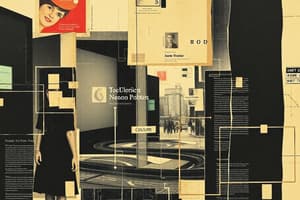Podcast
Questions and Answers
What is the difference between data and information?
What is the difference between data and information?
- Data is processed; information is raw facts.
- Data is unorganized facts; information is processed data. (correct)
- Data and information are the same.
- Data is organized; information is unorganized facts.
Which technology was used in first-generation computers?
Which technology was used in first-generation computers?
- Vacuum tubes (correct)
- Transistors
- Integrated circuits
- Microprocessors
What was a key feature of third-generation computers?
What was a key feature of third-generation computers?
- They used vacuum tubes for processing.
- They were primarily based on punch cards.
- They utilized transistors for efficiency.
- Integrated circuits were employed for the first time. (correct)
What distinguishes fourth-generation computers from previous generations?
What distinguishes fourth-generation computers from previous generations?
What future technology is anticipated for fifth-generation computers?
What future technology is anticipated for fifth-generation computers?
Flashcards
Data
Data
Raw, unorganized facts that can be in the form of text, graphics, audio, or video.
Information
Information
Data that has been processed into a meaningful form. Essentially, information gives meaning to raw data.
First-generation Computers (1946-1957)
First-generation Computers (1946-1957)
The first generation of computers, known for their large size and reliance on vacuum tubes, were used from 1946 to 1957.
Second-generation Computers (1958-1963)
Second-generation Computers (1958-1963)
Signup and view all the flashcards
Third-generation Computers (1964-1970)
Third-generation Computers (1964-1970)
Signup and view all the flashcards
Study Notes
Introduction to Application of Information and Communication Technology (CS-143)
- Course: Application of Information and Communication Technology (CS-143)
- Lecture: 02
- Instructor: Sajiya Tariq
Lecture Outline
- Data vs. Information
- Generations of Computer
Data vs. Information
- Data: Raw, unorganized facts. Can be text, graphics, audio, or video.
- Information: Data that has been processed into a meaningful form.
- Information Processing: Converting data into information.
Computers Then and Now
First Generation (1946-1957)
- Enormous computers powered by vacuum tubes.
- Used a large amount of electricity, generating significant heat.
- Examples: ENIAC and UNIVAC.
Second Generation (1958-1963)
- Used transistors.
- Computers were smaller, more powerful, cheaper, more energy-efficient, and more reliable.
- Used punch cards and magnetic tape for input and storage.
Third Generation (1964-1970)
- Used integrated circuits (ICs).
- Hard drives were used for storage.
- Keyboards and monitors became commonplace.
Fourth Generation (1971-present)
- Used microprocessors.
- Examples: IBM PC, Apple Macintosh.
- Used keyboards, mice, monitors, and printers.
- Employed magnetic disks, flash memory, and optical disks for storage.
- Computer networks, wireless technologies, and the Internet were introduced.
Fifth Generation (now and the future)
- Still in its infancy stage.
- Possibly based on artificial intelligence (AI).
- Potentially using voice and touch input.
- May be based on optical computers and utilize nanotechnology.
Studying That Suits You
Use AI to generate personalized quizzes and flashcards to suit your learning preferences.




